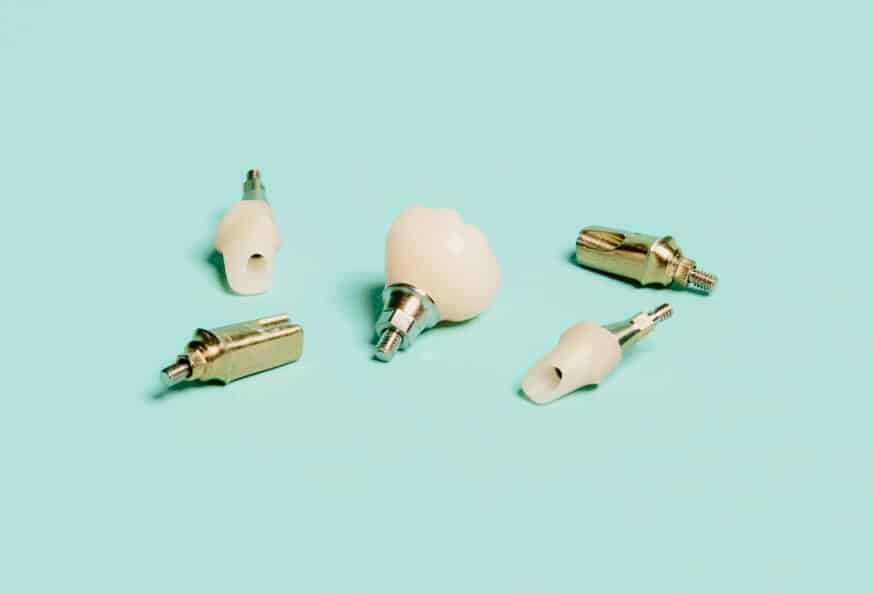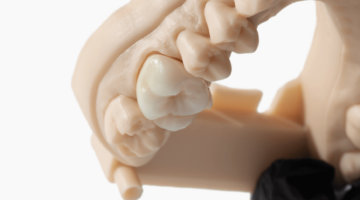When patients aren’t candidates for crowns placed atop or over an existing tooth, you’re going to be considering implants. Missing teeth (or teeth needing extraction) typically lead dentists to consider the more permanent process of adding dental implants, in which an “abutment” is surgically affixed to the jawbone. New crowns are attached to these abutments, and for more than 50 years, dentists have used titanium, now the most common material.
And they make sense—titanium dental implants are reliable, durable, and have basically become the industry standard, especially for patients who’ve lost teeth in accidents or who have significant tooth decay, infections, or periodontal disease. And titanium abutments are designed to be nearly permanent and are ultra-versatile, meaning that it’s unlikely another metal as cheap and reliable will unseat titanium as the industry-standard abutment material.
However, recent advances in CAD/CAM Dentistry and the proliferation of zirconia as a popular crown material have led to zirconia’s adoption as a new alternative to the titanium post. So, which is best when it comes to zirconia vs. titanium implants? We’ll compare.
Zirconia implants
Zirconia is a translucent metallic oxide that mimics the look of natural teeth remarkably while also delivering unparalleled toughness and durability. It is one of the most durable materials available for tooth replacement, and when used in crowns, the ultra-strong material is typically milled with a machine, to specifications provided by digital scanning.
Zirconia implant abutments are similarly produced from a monolithic block of zirconia and designed, using CAD/CAM technology, to the shape and specifications of a patient’s specific implant needs prior to milling. Dandy custom-designs zirconia abutments over titanium-bases, for the specific cases where patients and clinicians prefer the material’s benefits, which include biocompatibility, aesthetics, and strength.
Zirconia implant biocompatibility & osseointegration
Bacteria has a hard time forming around zirconia implants, aiding better long-term oral health, and biocompatibility. Additionally, zirconia has shown strong potential for osseointegration, the process by which existing (jaw) bone (and biological material) can successfully integrate or “interlock” with prosthetics and abutments, leading to longer-term strength and success for the implant. A popular in for the application of other medical prosthetics, zirconia’s ability to “fuse” with bone is promising.
Zirconia implant strength
Zirconia is one of the strongest technical ceramics available. In crowns, zirconia is often used for back teeth, where grinding and bite are more powerful forces. The fracture toughness and corrosion resistance are second to none in the landscape of ceramic materials for implants, although not as durable as titanium implants, so when weighing the benefits zirconia implants vs. titanium, it’s important to keep this in mind.
Zirconia implant aesthetics
Zirconia shines in the smile zone. Of course, one of the primary benefits of zirconia abutments is a benefit they share with zirconia crowns: the material’s translucent, white color mimics natural teeth. This means that zirconia implants themselves are less noticeable, especially for patients with thin tissue where the implants might be visible at the gumline. It also, like titanium and metal implants, is radiopaque, meaning it shows up on X-rays and scans.
Pros and cons of zirconia implants
As zirconia crowns have grown in popularity, so too have implants: they are are strong, esthetically great-looking, and biocompatible, which makes them a great choice for many implant candidates. And the aesthetic benefits especially are great, and a driving factor in zirconia’s adoption by so many dental practices and labs. So what are the drawbacks, if any? First, zirconia is strong and can osseointegrate, but it is still not as strong as titanium. If you’re looking for the absolute most durable abutment on the market, metal is still the answer. And, for practical purposes—there are very few implant cases where abutment color and shade are an actual concern. As zirconia remains more expensive than its metal counterparts, it might make sense in most cases to go with the industry standard. As always, the best option is still the one that benefits a specific patient—the goal of dentistry is always going to be a patient-specific best solution.
Titanium implants
Whether screwed into the jawbone or cemented in place, custom titanium implants are durable bases for crowns of all materials, and with a digital workflow, the most popular replacement option for missing teeth or those with no roots. Titanium implants are designed after an impression or digital scan gives clinicians and labs the information they need to design a crown. The implant itself can be placed and configured with CAD/CAM technology to minimize invasiveness before the dentist or dental surgeon places the implant body in the gum.
After 3-6 months, the titanium implant will fuse with the bone, via the same osseointegration that is promising in zirconia fixtures. This fusion of bone and titanium helps your crown and jaw withstand tremendous biting pressures. Patients wear a “healing cap” during this period and before their crown is (easily and simply) attached to the titanium implant.
Titanium implant biocompatibility & osseointegration
As discussed, titanium implants are biocompatible for most patients. As an inert metal, titanium very rarely affects the surrounding gums and teeth, and the implants typically osseointegrate very well with jawbone, given enough recovery time. Titanium remains the most common abutment material because of the newness of zirconia as well as titanium’s ability to work with the body. Of course, as with any material (including zirconia), not every implant will be successful, but titanium implants have a very high success rate. While there is no boilerplate, everything-solution for tooth replacement, for the most part titanium is the go-to.
Titanium implant strength
Titanium abutments and implants are tough. They resist fracture due to strong bites or use over time, but compared to ceramic implants like zirconia or zirconia blends, they also exhibit greater flexural strength — the bending or pushing that often causes fracture among more brittle replacement materials. Corrosion resistance and durability are so impressive that many patients have reported success over their entire lifetimes.
Titanium implant aesthetics
How do they look? They look like metal posts. But it’s important to remember that a titanium implant doesn’t need to be as aesthetically pleasing as basically any other dental prosthetic. Abutments are capped and covered with crowns, so the aesthetic success of a replacement is mostly dependent on the crown and its fit and finish, not the implant.
Pros and cons of titanium implants
There’s a reason titanium is the industry standard for dental implants. Titanium alloys deliver osseointegration, cost, strength, and general biocompatibility that all align to most implant patients’ needs. Titanium implants provide full support for crowns, along the lines of teeth themselves, and are versatile for a complexity of crown cases and even some bridges. The material can even, when it fuses with jawbone, improve bone health and longevity.
Custom abutments with Dandy: titanium and zirconia
Of course, all cases are contingent on the tooth, mouth, and patient, but whether your practice and cases are trending toward titanium or zirconia implants, Dandy’s got you covered. Our digital dental laboratory gives you the option to work with either material for custom abutments, helping your practice streamline and build efficiencies to deliver positive results through strong and aesthetic smiles.



